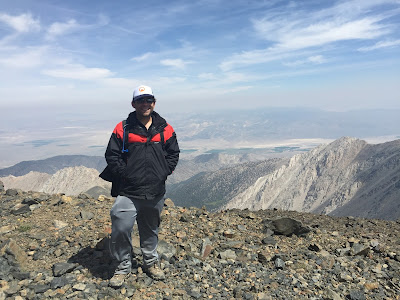After returning from our trip to Turkey, and resting for a few weeks, it was time for another CT scan. Below are the impressions:
- New soft tissue density nodule in the right lower lobe is concerning for metastasis.
- The post-ablation area in the medial right lower lobe in the region of the azygoesophageal recess has become more consolidative and slightly enlarged. This finding is concerning for progression.
- The previously seen 3 mm nodule in the right middle lobe appears to be slightly enlarging, particularly when compared to CT thorax 3/26/2015.
- Multiple other stable small nodules as mentioned above.
Fighting this cancer has destroyed my body over the years. It's extremely frustrating having to start from ground zero so many times, but every time I want to give up, I dig deep, and take one more step. The single steps eventually add up to hundred of thousands of steps and rebuilding of my strength and spirit. It's during these times that you learn what you're truly capable of.
Cancer wasn't going to stop me from living my life. The plan would be to go on one more adventure and summit two mountains: Mount Dana (13,061 feet) and White Mountain Peak (14,252 feet), and then undergo a cryo and micro ablation procedure. Each would be hard in its own way, but I knew I had what it took to conquer both.
Enjoy our adventures!
Mt. Dana Summit (13,061 ft.)
White Mountain Peak Summit (14,252 ft.)
Post cryo and micro ablation.
Yosemite National Park
Mount Dana
(6 miles; 5-6 hours; 3,118 feet elevation gain)
Labor Day weekend crowds.
Mount Dana is the second highest mountain in Yosemite National Park with an elevation of 13,061 feet. The trailhead begins at the Tioga Pass Park Entrance.
Follow the path towards the tree line.
View of Dana Meadows.
After reaching a plateau above the tree line, almost all vegetation disappears.
The brutal uphill continues.
We made it to the top!
U.S. Coast and Geodetic Survey marker for Mount Dana.
Spectacular view of Mono Lake.
Slow and steady decent down the mountain.
Breathtaking sunset.
On to the next mountain.
White Mountain Peak, Bishop, CA
(15 miles; 7-9 hours; 3450 feet elevation gain)
At 14,252 feet, White Mountain Peak is the third highest peak in California after Mount Whitney and Mount Williamson.
The Barcroft Observatory small dome was built in the 1960's to study the moon and planets at infrared wavelengths. In September 2003, the UCSB Astrophysics Group designed and installed the MPOL telescope to determine aspects of the polarization of the cosmic background radiation. Go Gauchos!
White Mountain Peak is part of the Inyo-White Mountains which are composed of some of the oldest sedimentary rocks in California with fossils dating around 600 million years old.
White Mountain Peak has an exposed desert mountain climate. There's no water or shade along the way, and winds can reach over 160 mph!
The last stretch goes straight up.
The summit is composed of lava lifted and melted by rising granite (metavolcanic rock).
To the west are the Sierras.
To the east is Nevada and Death Valley.
Signing the trail register.
U.S. Coast and Geodetic Survey marker for White Mountain Peak.
White Mountain Research Center Summit Lab.
The high altitude has gotten to Andrew's brain.
The Barcroft Station is highest research facility in North America, and is run by the University of California.
Devils Postpile National Monument
The monument is located on the western slope of the Sierra Nevada range between 7,200 and 8,200 feet.
A 400 feet deep lava lake filled the valley 100,000 years ago. As the lava cooled, cracks formed on the surface to release built up tension. The cracks deepened as the interior cooled to form basaltic columns.
The formation is one of the finest examples of visible basaltic columns in world.
The flora and fauna are typical of the Sierra Nevada. Visitors can see animals and plants such as black bear, eagles, pine and fir trees, as well as many wildflowers.
Making our way to the top.
The glacial event exposed the basaltic columns, and polished smooth the top formation enhancing the pattern of hexagons.
Beautiful view of Reds Meadow Valley below.
The Minarets
The Minarets are a series of jagged peaks located in the Ritter Range.
Their sawtooth appearance were created by the freezing and expansion of water from rain and snow which seeped into cracks in the rock.
Mono Lake Tufa State Reserve
Mono Lake is estimated to be more than a million years old making it one of the oldest lakes in North America. It encompasses 60 square miles: 13 miles east-west by 8 miles north-south.
The Eastern Sierra streams carry down fresh water laden with salts and minerals. With no outlet, water can only leave the basin through evaporation, and the salts and minerals are left behind. As a result, Mono Lake is 2.5 times as salty and 80 times as alkaline as ocean water.
South Tufa Formations.
The unusual spires and knobs are formed when fresh water springs containing calcium bubble up through the carbonate rich lake water. The combining of these waters forms calcium carbonate, a whitish limestone deposit that forms the basis of the tufa formations.
Tufa (calcium carbonate) = Mono Lake water (carbonates) + freshwater springs (calcium)
Tufa (too-fah).
Even though fish are unable to live these high salt concentration waters, Mono Lake is one of the most productive lakes in the world, supporting brine shrimp, alkali flies, and migratory birds.
The Native Americans who lived in the Mono Basin, the Kutzadika'a, collected the abundant alkali fly pupae and used them as one of the main food sources and trade item.
Mama Mia, that's a big tufa!
The towers at South Tufa are estimated to be younger than 300 years old. Far older tufa towers, some as old as 13,000 years, are found high above the current lake, along Mono's ancient shore.
Let's bee friends.
Goodbye!


















































